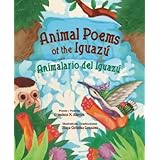
Bibliography-
Franco, Betsy. 2009. Messing Around on the Monkey Bars: And Other School Poems for Two Voices. Ill. by Jessie Hartland. Sommerville, MA: Candlewick Press. ISBN – 9780763631741.
Critical Review-
Franco creates a wonderful collection of poems that celebrates the fun of poetry reading. The anthology has a table of contents to assist in finding the exact poem for the occasion. Also, an author’s note illustrates the font styles that are provided to facilitate reading the poems by multiple voices. While there are three separate font styles (one for voice 1, one for voice 2, and one for both), there are many ways to use the font styles to incorporate a variety of readings. In most poems, it is easy to distinguish the three font styles; however, some are a little difficult to spot. For example in the poem, “In the Library,” it is difficult to tell if the intent is for the font to match the style for “both” or is it larger to show that the librarian is shouting.
Most of the poems rhyme and all are very rhythmic which readily lends themselves to various ways of choral reading. Also, these poems are great for performance poetry. Many are easily adaptable to movement or sound effects making this collection very attractive to children. In addition at the back of the book, Franco provides some suggestions for incorporating some fun and engaging ways to read and perform the poems in a section labeled, “adventurous ways to read the poems.” All of the poems are so engaging, it is not difficult to develop your own creative way of sharing the poems.
The illustrations are as entertaining as the poems. The drawings done in gouache resemble child drawings. Each illustration adds to the meaning of the poem with wonderful detail. In particular are the fantastic facial expressions on the characters whether people or inanimate objects. Each one is brought to life by its perfect demonstration of expression. In the poem, “Lunch Money,” the expression on the face of the boy in the lunch line who realizes that he has a hole in his pocket is priceless. The angry sister in “I Can’t Wait,” is not only hilarious but unmistakably mad. Below is an example of a poem from this enjoyable collection.
Wild Bus Ride
By Betsy Franco
Snort, squeal,
snort, squeal.
We're gobbled up
by a beast with wheels.
Grumble, growl,
grumble, growl.
The beast shoots smoke.
It moans and howls.
Jumble, rumble,
jumble, rumble.
Its big old belly
groans and grumbles.
Screech, cough,
screech, cough.
It opens its mouth--
we scramble off.
Snort, squeal,
growl, grumble.
The beast is gone
with a rumble, rumble.
Kid Connection –
To introduce this poem, have children share some of their adventures when riding on the school bus. Next, model the reading of the poem by reading it out loud to the children. Then, point out that some of the lines are in darker words than other lines. Explain to the children that this is to indicate different speakers. Divide the class into two groups and lead them in reading the poem with one group reading the lighter text and the other group reading the darker text. For added fun, the children could read the poem using sound effects for words like “snort,” “squeal,” “growl,” and “cough.”





